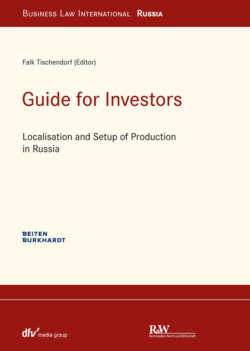Читать книгу Guide for Investors - Falk Tischendorf - Страница 8
На сайте Литреса книга снята с продажи.
2. Government programs/strategies
ОглавлениеSince the early 2000s, the government has been taking measures to stop any further disintegration of Russian industry and to gradually bring the country up to a competitive international level. Based on the experience of the Soviet period it was clear that the size of the sales market plays a decisive role in the revival of domestic industry.
The industrial sectors related to strategic raw materials were the priority for the Russian Government. This means, first and foremost, fossil fuels. After a short period of privatization, they once again ended up almost entirely under the direct or indirect control of the Russian Government and under state supervision, and accounted for more than 50 % of Russian GDP.
Then you have the manufacturing and processing sector, including the automotive industry, which is designated as a key industrial sector of strategic importance.
Due to favorable oil price trends during the period from 2000–2014 and the related revenues of the Russian state over these 15 years, the key industrial sectors stabilized and were backed by promising investments and international knowhow.
In this regard, the automotive industry has benefited from several state programs, the most famous being Resolution No. 166 of the Russian Government dated 29 March 2005 on the localisation of automobile manufacturers. Together with various regional programs to support the localisation of production, the country managed to create a situation where nearly all the best-known international automobile manufacturers have modern production facilities in Russia that meet all international standards. Twenty automotive manufacturers are concentrated in the European part of Russia, in the cities of Togliatti, Elabuga, Naberezhnye Chelny and Ulyanovsk in the Volga Region, as well as in Nizhny Novgorod, Saint Petersburg, Moscow, Kaluga and Kaliningrad.
The installed production capacity of all truck and automobile manufacturers together equals 3.7 million vehicles a year. However, utilization has reportingly fallen from nearly 65 % in 2012 to around 35 % in 2016 and recovered to just about 50 % today. The decision of first GM in 2018 and then Ford in 2019 to close their production activities in Russia is certainly somehow connected to the low utilization levels.
An important component of Resolution No. 166 concerns the customs privileges on the import of parts for the manufacture of vehicles through semi-knockeddown (SKD) and complete knock-down (CKD) assembly. In this regard, defined production capacities must be built and maintained in order to achieve the set level of localisation by the established deadlines. To support this process for the automotive industry, Resolution No. 566 of the Russian Government dated 16 September 2006 was passed, which also applies to the achieved level of localisation for certain products and technologies that are also eligible for customs privileges on the import of the materials and parts necessary to manufacture auto components and units.
The first manufacturers began production in accordance with Resolution No. 166 in 2007. Shortly afterwards, suppliers of automotive components began their manufacture in accordance with Resolution No. 566. However, in their current form these resolutions do not meet WTO requirements, meaning that based on the agreement on Russia’s accession to the WTO the “industrial assembly” arrangements must be brought into line with WTO rules by 1 July 2018. This does not affect the validity of the agreements concluded with companies by the Ministry of Economic Development of Russia. The Russian ministries are since then in the process of amending the resolutions to comply with WTO provisions. This is done by a subsidy scheme based on retrospective compensation via the Russian Ministry of Industry and Trade and the Ministry of Economic Development.
